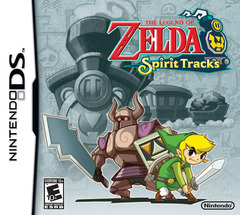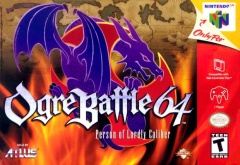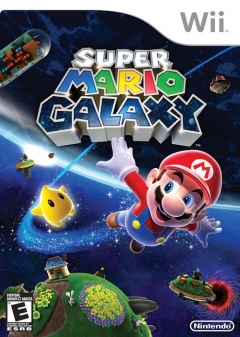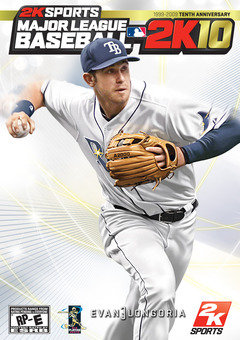Full Reviews
Full game reviews as we beat them, there will be a balance of both new and old games reviewed. We review the basics of the game and deliver scores in a few categories and an overall score out of 10.
The Legend of Zelda: Spirit Tracks
 This is a first for us, but this is our second full review of The Legend
of Zelda: Spirit Tracks on the First Hour. Paul first reviewed the game in
early February and praised it for its stellar action and improved
controls over Phantom Hourglass. He did note some
issues with the train in the game, and while most of my opinions will
echo his, I would like to get my thoughts down before I move on to other
games.
This is a first for us, but this is our second full review of The Legend
of Zelda: Spirit Tracks on the First Hour. Paul first reviewed the game in
early February and praised it for its stellar action and improved
controls over Phantom Hourglass. He did note some
issues with the train in the game, and while most of my opinions will
echo his, I would like to get my thoughts down before I move on to other
games.
This is Nintendo's second attempt at going for an entirely stylus-driven Zelda experience. I'm actually still a bit shocked that this works. It's not perfect, but it is definitely not substantially worse than playing a console Zelda game, and in some ways works better than the old 2D games. Paul said he noticed improvements in the control, but either it's been so long since I played Phantom Hourglass that I didn't notice, or... they didn't make any improvements. I'm guessing the former as I was rarely frustrated with the game control-wise.
Just like to quickly mention how awesome it is that we got two Legend of Zelda games on the Nintendo DS, especially considering it was nearly three years after the system debuted that Phantom Hourglass finally landed. It'd be great to see a third, but I imagine Nintendo will be refocusing their efforts on the DSi or 3DS at this point. Hey, you can always hire Capcom to make more portable iterations.Ogre Battle 64: Person of Lordly Caliber
 Ogre
Battle 64: Person of Lordly Caliber is a mixed game, and has had mixed
reviews. Some hold it as the holy grail of RPG/Strategy gaming, while
others find it about as entertaining as a box of rocks.
Ogre
Battle 64: Person of Lordly Caliber is a mixed game, and has had mixed
reviews. Some hold it as the holy grail of RPG/Strategy gaming, while
others find it about as entertaining as a box of rocks.
I’m of the former. When I saw this game in Nintendo Power, and read about it, it was all new to me. I never played its SNES predecessor. But it looked so awesome. Being an RPG fan, and desperately wanting a reason to play my Nintendo 64 other than to play Super Smash Bros. or Star Fox. The game Quest 64 left a terrible taste in my mouth and made me desperately want a Playstation for some good RPG games.
Ben There, Dan That! and Time Gentlemen, Please!
 So as I'm moving through my Steam
backlog, my next games are the adventure duo Ben There, Dan That! and
its sequel Time Gentlemen, Please! Both are old-school 2d adventure
games, harking back to classics such as Maniac Mansion, Loom, Monkey
Island and Sam & Max (admittedly, none of which I have played
aside from the free Sam & Max episode on Steam).
So as I'm moving through my Steam
backlog, my next games are the adventure duo Ben There, Dan That! and
its sequel Time Gentlemen, Please! Both are old-school 2d adventure
games, harking back to classics such as Maniac Mansion, Loom, Monkey
Island and Sam & Max (admittedly, none of which I have played
aside from the free Sam & Max episode on Steam).In case you aren't familiar with the PC adventure game genre, they're dialogue-heavy puzzle/detective games of a sort. You walk around, talk to people, pick things up, interact with objects and generally figure out ways to progress to your next or overall objective. It's generally very simple to play, not requiring twitch skills or muscle memory like most modern games and can be taken at whatever pace you wish. The humor of the games are by far their biggest draw, with large amounts of clever, lighthearted, endearing dialogue. Of course, then the dialogue is the main draw of the genre and allows it to stand out over say, an electronic version of Clue. Other significant factors towards the final product include ambience, intelligent pacing and a basic yet effective control scheme. The genre as a whole has a fairly rabid dedicated fanbase. This is in contrast to the majority of the gaming world, who doesn't even know that the genre exists.
Super Mario Galaxy
 I loved Super Mario 64. It was the first game I ever played on what is
one of my favorite consoles, and my memories of the game have stuck
with me to this day. The running, the jumping, the exploration of huge
levels, it was incredible. Mario made the best transition to 3D ever,
well, until Ocarina of Time
came around. The next 3D Mario iteration was Super Mario Sunshine,
which I was less then enthused about. I'm not sure if it was the water
pack gimmick or what, but I was never convinced that it would be worth
playing. Nintendo has finally delivered its third true 3D Mario game
(well, two and a half years ago) with Super Mario Galaxy. While it is almost unrecognizable in terms of what a Mario game should be like, it plays just like Mario 64 did 14 years ago: awesomely.
I loved Super Mario 64. It was the first game I ever played on what is
one of my favorite consoles, and my memories of the game have stuck
with me to this day. The running, the jumping, the exploration of huge
levels, it was incredible. Mario made the best transition to 3D ever,
well, until Ocarina of Time
came around. The next 3D Mario iteration was Super Mario Sunshine,
which I was less then enthused about. I'm not sure if it was the water
pack gimmick or what, but I was never convinced that it would be worth
playing. Nintendo has finally delivered its third true 3D Mario game
(well, two and a half years ago) with Super Mario Galaxy. While it is almost unrecognizable in terms of what a Mario game should be like, it plays just like Mario 64 did 14 years ago: awesomely.
Galaxy's gimmick is that instead of featuring one giant, flat plane, each world is made up of small, Little Prince-like planets and objects. Gravity and physics are now Mario's biggest friend and foe, as you're constantly being challenged in new ways to jump and explore. I love games like Braid and Portal that challenge me to think and play different, Super Mario Galaxy joins that elite group, in my opinion.Super Mario Galaxy 2 is due in less than two months, and it'll probably be the first Wii game I buy at launch in over three years. I'd love to have a first hour review of that game at launch (hint, hint, Nintendo), but I've got a first hour review of this game also on the back burner. Here's my full review of Super Mario Galaxy. I collected all 120 stars in the game which took me about 25-30 hours.
Mirror's Edge
 Here we have Mirror's Edge, a first-person platformer of sorts, released in late 2008/early 2009 by DICE/EA. I've been interested in the game for a while, starting from its strong marketing campaign, so I jumped on the chance to play it recently.
Here we have Mirror's Edge, a first-person platformer of sorts, released in late 2008/early 2009 by DICE/EA. I've been interested in the game for a while, starting from its strong marketing campaign, so I jumped on the chance to play it recently.It can be briefly summarized that in Mirror's Edge, you are a runner, tasked to transfer information between groups looking to avoid the surveillance of an overbearing government and its allies. As escaping capture is of utmost importance, runners do most of their travel on free outdoor environments, especially rooftops. Thus the gameplay is largely parkour-based, emphasizing proper use of momentum, speed and techniques to accomplish goals. At its best, this leads to a smooth, sublime experience, reminiscent of games like Jet Set Radio, Shadow of the Colossus, NiGHTS, and the original Prince of Persia. Mirror's Edge takes the player further into that experience, locking you to a first-person view with constant reminders of your physical struggles with and against the forces of gravity and objects in your world.
Major League Baseball 2K10
 Another year, another sports game. Gamers hear this every few months when the newest Madden is coming out, or the next iteration in a 2K series, or even for the Tiger Woods series. Sure, you updated the roster, but what did you really spend the last 12 months on? That is the eternal question for series with annual updates, and it's always one someone is forced to answer.
Another year, another sports game. Gamers hear this every few months when the newest Madden is coming out, or the next iteration in a 2K series, or even for the Tiger Woods series. Sure, you updated the roster, but what did you really spend the last 12 months on? That is the eternal question for series with annual updates, and it's always one someone is forced to answer.
For 2K Sports' MLB series, 2009 was a rough year. The series was switching developers and reactions from the fanbase was generally bad. With Sony's rival series, The Show, growing stronger and stronger with every iteration, it was not a good year to take two steps back. 2K and Visual Concepts desperately needed to show that they still worth the MLB license they paid for: 2K10 needed to be the Comeback Player of the Year. If you believe Metacritic, they have definitely improved. 2K9 has a metascore of 64 with a user score of only 5.2, whereas 2K10 has a metascore of 76 but even more importantly, a user score of 8.0. The MLB 2K series seems to be back on the right track.
But I never played a previous iteration of the series, let alone 2K9, so I'm coming into this season as a rookie. I'm still expecting a lot though, my favorite baseball games are more arcadey, like Base Wars or the Ken Griffey Jr. series. Those games were just pure fun and the gameplay was great not because it was great baseball, but because it was a great video game. MLB 2K10, however, is realistic and trying to not let you realize that it is a video game. Quite a bit different than what I'm used to.
So here's my full review of MLB 2K10, this was a review copy provided to me by 2K Games. You can see read my "first hour review" of the game that actually follows me through about the first 10 hours of the game.The Incredible Hulk: Ultimate Destruction
 "Comic book video game." Maybe not the most successful four-word combination in the history of the world. But you can't blame them for trying, right? What could be cooler than playing as your favorite super-hero? The premise of Ultimate Destruction is that you play as the Hulk, and the Hulk smashes things. And although there's more to the game than that, smashing things is the basis of the gameplay, and guess what. It's fun.
"Comic book video game." Maybe not the most successful four-word combination in the history of the world. But you can't blame them for trying, right? What could be cooler than playing as your favorite super-hero? The premise of Ultimate Destruction is that you play as the Hulk, and the Hulk smashes things. And although there's more to the game than that, smashing things is the basis of the gameplay, and guess what. It's fun.
This game was developed by Radical Entertainment and released in August 2005 for XBox, PS2, and GameCube.
Ultimate Destruction is an open-world game. Basically, there are three areas. Two of the areas are huge, the third is a hub that is much smaller. In each area, you can go wherever you want and do whatever you want. And by that I mean smash whatever you want. The main progression of the game involves buying new moves for hulk to smash things. In order to unlock new moves, you play through story missions. The story missions are normal comic book video game fare, and they mostly boil down to smashing things, getting from point A to point B while smashing things, or smashing things while trying to keep something from being smashed.Tatsunoko vs. Capcom: Ultimate All-Stars
Tatsunoko vs. Capcom: Ultimate All-Stars is the latest installment in the crossover series developed by Eighting and published by Capcom. Originally released in Japan more than a year ago (Dec 11, 2008), Tatsunoko vs. Capcom is finally making it's stateside debut January 26th, 2010.
You may be asking yourself, "Who the heck are these Tatsunoko characters?". I myself am asking this same question as I venture into this unknown universe. To my current knowledge, it is basically one of the grandfather anime production studios that really took off in the 80s and early 90s in Japan. Most of their work made it overseas with the likes of Samarai Pizza Cats, G-Force, and Robotech. If you grew up with cartoons in the 90s, there is a chance you will run across some familiar faces here (though you may have forgotten their names).
Capcom took a huge gamble bringing such an unknown universe stateside. To put the odds in their favor, the game has gained a few critical changes. First off, online match making has been included. Secondly, at the cost of losing one character from the original Japanese game due to licensing issues (see Hakushon Daimaō), Capcom has graciously added five new playable characters to the international version of the game.
This game was never originally planned to make it over here. I was able to play the title while I was over in Japan a year ago and was super excited to hear Capcom was putting so much effort into bringing it overseas. The game definitely warrants a purchase and fills the empty void of 2D fighters (with online) on the Wii. Hopefully word gets out about this game because I have a feeling it's going to be an uphill battle. I've lived in Japan for two years and I still don't know who half these Tatsunoko characters are.Gratuitous Space Battles
We finish off our second annual indie games month with Gratuitous Space Battles, an epic space battle simulator from Positech Games. During our first independent games month last year, we featured Kudos 2, a life simulator also created by the one man team of Cliff Harris at Positech Games. This guy likes his simulators, whether they're of space, life, or Democracy, but Gratuitous Space Battles is a seriously awesome game.
Gratuitous Space Battles is the first game I ever played of its kind. It's almost like one giant, single turn of a board game, or Civilization. Your opponent's pieces are in place and visible on the board, and it is your job to create and deploy a fleet of ships that can combat and destroy them, hopefully while taking minimal losses yourself. Once you click Fight, there's nothing else you can do. It feels very... unnatural at first, like the developer is taking away control of the most enjoyable part of the game. There are explosions and debris everywhere, and you want to be part of the action. But then you begin to realize that the actual simulation isn't the game, but everything before it.
It's fairly obvious that Gratuitous Space Battles is not a game for everyone. There's no real-time micro-management, no hotkeys to quick select a group of ships, and especially no mouse button spamming to get your point across. Gratuitous Space Battles is one of the finest, genre-defining games I've ever played. The game is simply in its own category. I honestly can't give the game a final score because I don't know what to compare it against.
Gratuitous Space Battles was developed for Windows but also works great in Wine on Linux, which is how I played it.
L!ght Deluxe
Simple yet complex? Possibly. Simply complex? Not quite right. I know it’s here somewhere and I think you get the point. L!ght Deluxe is a delightfully simple puzzle game from a new-to-me Indie Developer: Nemo Games. Looking at their website, it would appear that L!ght Deluxe is their first, or perhaps their only game. While the game definitely feels like an early effort, it shows promise and offers some interesting aspects to its gameplay.
L!ght deluxe is built on a basic concept that allows degrees of complexity to be added as you advance through the "levels". At its elemental level, you are trying to connect a line, uninterrupted, from its origin to its ultimate destination. Each puzzle takes place on a large grid, much like a Chess board. Early levels are smaller, perhaps grids that are 6 x 6 squares in size. However, as levels increase in complexity and difficulty, they get larger.
The line you are tasked with completing represents light and behaves as one would expect a beam of light (or laser to add a bit of intensity) to behave. In my opinion, it’s this foundational principle that allows the game to be successful much earlier than it would be otherwise. We all inherently understand that light bounces off reflective surfaces and changes colors as it passes or filters through other materials. The nature of light, and our assumed understanding of it, allows the developers to move more quickly with tutorials as we progress through the game and are introduced to the gradually increasing complexity of the puzzle designs.



